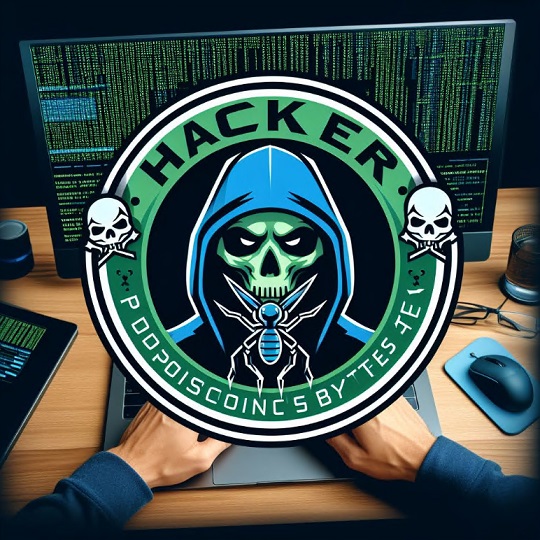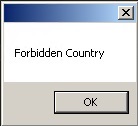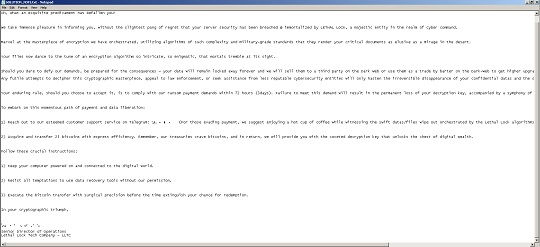Ransom.MSIL.CHAOS.THDAGBD
Win32:RansomX-gen [Ransom] (AVAST)
Windows


Threat Type: Ransomware
Destructiveness: No
Encrypted:
In the wild: Yes
OVERVIEW
Downloaded from the Internet, Dropped by other malware
This Ransomware arrives on a system as a file dropped by other malware or as a file downloaded unknowingly by users when visiting malicious sites.
It encrypts files with specific file extensions. It drops files as ransom note.
TECHNICAL DETAILS
897,536 bytes
EXE
No
17 Apr 2024
Displays graphics/image, Displays windows, Drops files, Encrypts files, Modifies system registry
Arrival Details
This Ransomware arrives on a system as a file dropped by other malware or as a file downloaded unknowingly by users when visiting malicious sites.
Installation
This Ransomware drops the following files:
- %Application Data%\SOLUTION_NOTE.txt
- %User Temp%\{9 Random Character}.jpg
(Note: %Application Data% is the current user's Application Data folder, which is usually C:\Documents and Settings\{user name}\Application Data on Windows 2000(32-bit), XP, and Server 2003(32-bit), or C:\Users\{user name}\AppData\Roaming on Windows Vista, 7, 8, 8.1, 2008(64-bit), 2012(64-bit) and 10(64-bit).. %User Temp% is the current user's Temp folder, which is usually C:\Documents and Settings\{user name}\Local Settings\Temp on Windows 2000(32-bit), XP, and Server 2003(32-bit), or C:\Users\{user name}\AppData\Local\Temp on Windows Vista, 7, 8, 8.1, 2008(64-bit), 2012(64-bit) and 10(64-bit).)
It drops and executes the following files:
- %Application Data%\svchost.exe → Executed with Escalated Privileges
(Note: %Application Data% is the current user's Application Data folder, which is usually C:\Documents and Settings\{user name}\Application Data on Windows 2000(32-bit), XP, and Server 2003(32-bit), or C:\Users\{user name}\AppData\Roaming on Windows Vista, 7, 8, 8.1, 2008(64-bit), 2012(64-bit) and 10(64-bit).)
Autostart Technique
This Ransomware adds the following registry entries to enable its automatic execution at every system startup:
HKEY_CURRENT_USER\Software\Microsoft\
Windows\CurrentVersion\Run
UpdateTask = %Application Data%\svchost.exe
Other System Modifications
This Ransomware adds the following registry entries:
HKEY_CURRENT_USER\Software\Microsoft\
Windows\CurrentVersion\Policies\
System
DisableTaskMgr = 1
It changes the desktop wallpaper by modifying the following registry entries:
HKEY_CURRENT_USER\Control Panel\Desktop
Wallpaper = %User Temp%\{9 Random Character}.jpg
It sets the system's desktop wallpaper to the following image:
- %User Temp%\{9 Random Character}.jpg

Propagation
This Ransomware drops the following copy of itself in all physical and removable drives:
- {Drive Letter}:\surprise.exe → Excluding drive C:\
Process Termination
This Ransomware terminates the following services if found on the affected system:
- BackupExecAgentBrowser
- BackupExecDiveciMediaService
- BackupExecJobEngine
- BackupExecManagementService
- vss
- sql
- svc$
- memtas
- sophos
- veeam
- backup
- GxVss
- GxBlr
- GxFWD
- GxCVD
- GxCIMgr
- DefWatch
- ccEvtMgr
- SavRoam
- RTVscan
- QBFCService
- Intuit.QuickBooks.FCS
- YooBackup
- YooIT
- zhudongfangyu
- sophos
- stc_raw_agent
- VSNAPVSS
- QBCFMonitorService
- VeeamTransportSvc
- VeeamDeploymentService
- VeeamNFSSvc
- veeam
- PDVFSService
- BackupExecVSSProvider
- BackupExecAgentAccelerator
- BackupExecRPCService
- AcrSch2Svc
- AcronisAgent
- CASAD2DWebSvc
- CAARCUpdateSvc
- TeamViewer
Other Details
This Ransomware does the following:
- It displays a message box and terminates execution if any of the input languages below is detected:
- Azerbaijan
- Turkey

Ransomware Routine
This Ransomware encrypts files with the following extensions:
- .aac
- .adt
- .adts
- .accdb
- .accde
- .accdr
- .accdt
- .aif
- .aifc
- .aiff
- .aspx
- .avi
- .bat
- .bin
- .bmp
- .cab
- .cda
- .csv
- .dif
- .dll
- .doc
- .docm
- .docx
- .dot
- .dotx
- .eml
- .eps
- .exe
- .flv
- .gif
- .htm
- .html
- .ini
- .iso
- .jar
- .jpg
- .jpeg
- .m4a
- .mdb
- .mid
- .midi
- .mov
- .mp3
- .mp4
- .mpeg
- .mpg
- .msi
- .mui
- .png
- .pot
- .potm
- .potx
- .ppam
- .pps
- .ppsm
- .ppsx
- .ppt
- .pptm
- .pptx
- .psd
- .pst
- .pub
- .rar
- .rtf
- .sldm
- .sldx
- .swf
- .sys
- .tif
- .tiff
- .tmp
- .txt
- .vob
- .vsd
- .vsdm
- .vsdx
- .vss
- .vst
- .vstm
- .wav
- .wbk
- .wks
- .wma
- .wmd
- .wmv
- .wmz
- .wms
- .wpd
- .wp5
- .xla
- .xlam
- .xll
- .xlm
- .xls
- .xlsm
- .xlt
- .xltm
- .xltx
- .xps
- .zip
- .au
- .class
- .cvs
- .dbf
- .fm3
- .hqx
- .mac
- .map
- .mtb
- .psp
- .qxd
- .ra
- .sit
- .tar
- .wk3
- .wpl
- .7z
- .arj
- .deb
- .pkg
- .rpm
- .tar.gz
- .z
- .dmg
- .toast
- .vcd
- .dat
- .db
- .log
- .sav
- .sql
- .xml
- .emlx
- .msg
- .oft
- .ost
- .vcf
- .gadget
- .sh
- .wsf
- .fnt
- .fon
- .otf
- .ttf
- .ai
- .ico
- .ps
- .scr
- .svg
- .webp
- .asp
- .cer
- .cfm
- .css
- .jsp
- .part
- .php
- .py
- .rss
- .xhtml
- .key
- .odp
- .apk
- .c
- .cpp
- .cs
- .h
- .java
- .swift
- .vb
- .ods
- .bak
- .cfg
- .cpl
- .cur
- .dmp
- .drv
- .icns
- .lnk
- .3g2
- .3gp
- .h264
- .m4v
- .mkv
- .rm
- .webm
- .contact
- .settings
- .xlsx
- .odt
- .mka
- .mhtml
- .oqy
- .mdb
- .cub
- .dae
- .indd
- .dwg
- .lnk
- .dib
- .dic
- .divx
- .7zip
- .ace
- .bz2
- .cab
- .gzip
- .lzh
- .xz
- .torrent
- .core
- .pdb
- .wmv
- .cer
- .backup
- .bay
- .p7c
- .exif
- .raw
- .sie
- .sum
- .ibank
- .wallet
- .rb
- .xlsm
- .xlsb
- .jpe
- .blob
- .xlw
- .xsd
- .xsf
- .xsl
- .kmz
- .stm
- .accdt
- .1cd
- .3fr
- .adp
- .ai3
- .ai4
- .ai5
- .ai6
- .ai7
- .ai8
- .arw
- .ascx
- .asm
- .asmx
- .avs
- .cfm
- .dbx
- .dcm
- .dcr
- .pict
- .rgbe
- .dwt
- .f4v
- .exr
- .kwm
- .max
- .mda
- .mdf
- .mdw
- .mht
- .mpv
- .myi
- .nef
- .odc
- .geo
- .odm
- .oft
- .orf
- .pfx
- .p12
- .pl
- .pls
- .safe
- .tab
- .vbs
- .xlk
- .xlm
- .xltx
- .pptx
- .pot
- .xps
- .xsf
- .xsl
- .pptm
- .potm
- .xltx
- .pptm
- .potm
- .pot
- .xlw
- .kmz
- .accdr
- .accdw
- .acda
- .accdc
- .accdw
- .bin
- .ascx
- .asm
- .asmx
- .avs
- .cfm
- .dbx
- .dcm
- .dcr
- .rgbe
- .f4v
- .exr
- .kwm
- .max
- .mda
- .mdf
- .mdw
- .mht
- .mpv
- .myi
- .nef
- .odc
- .geo
- .odm
- .orf
- .pfx
- .p12
- .pl
- .pls
- .safe
- .tab
- .vbs
- .xlk
- .xlm
- .xlt
- .pptm
- .potm
- .xltx
- .xps
- .xsf
- .xsl
- .pptm
- .potm
- .xltx
It avoids encrypting files with the following strings in their file name:
- boot.ini
- bootfont.bin
- boot.ini
- iconcache.db
- ntuser.dat
- ntuser.dat.log
- ntuser.ini
- thumbs.db
- autorun.inf
- bootsect.bak
- desktop.ini
It avoids encrypting files with the following strings in their file path:
- appdata\local
- appdata\locallow
- users\all users
- \ProgramData
It avoids encrypting files found in the following folders:
- In Drive C, it will avoid the following directories:
- %User Profile%\Desktop
- %User Profile%\Links
- %User Profile%\Contacts
- %User Profile%\Desktop
- %User Profile%\Documents
- %User Profile%\Downloads
- %User Profile%\Pictures
- %User Profile%\Music
- %User Profile%\OneDrive
- %User Profile%\Saved Games
- %User Profile%\Favorites
- %User Profile%\Searches
- %User Profile%\Videos
- %User Profile%\AppData\Roaming
- %Public%\Documents
- %Public%\Pictures
- %Public%\Music
- %Public%\Videos
- %Public%\Desktop
(Note: %Public% is the folder that serves as a repository of files or folders common to all users, which is usually C:\Users\Public in Windows Vista, 7, and 8.)
It appends the following extension to the file name of the encrypted files:
- .LethalLock
It drops the following file(s) as ransom note:
- {Encrypted Directory\SOLUTION_NOTE.txt

SOLUTION
9.800
19.310.03
30 Apr 2024
19.311.00
01 May 2024
Step 1
Trend Micro Predictive Machine Learning detects and blocks malware at the first sign of its existence, before it executes on your system. When enabled, your Trend Micro product detects this malware under the following machine learning name:
- TSPY.Win32.TRX.XXPE50FFF080
Step 2
Before doing any scans, Windows 7, Windows 8, Windows 8.1, and Windows 10 users must disable System Restore to allow full scanning of their computers.
Step 3
Note that not all files, folders, and registry keys and entries are installed on your computer during this malware's/spyware's/grayware's execution. This may be due to incomplete installation or other operating system conditions. If you do not find the same files/folders/registry information, please proceed to the next step.
Step 4
Delete this registry value
Important: Editing the Windows Registry incorrectly can lead to irreversible system malfunction. Please do this step only if you know how or you can ask assistance from your system administrator. Else, check this Microsoft article first before modifying your computer's registry.
- HKEY_CURRENT_USER\Software\Microsoft\Windows\CurrentVersion\Policies\System
- DisableTaskMgr = 1
- HKEY_CURRENT_USER\Software\Microsoft\Windows\CurrentVersion\Run
- UpdateTask = %Application Data%\svchost.exe
- HKEY_CURRENT_USER\Control Panel\Desktop
- Wallpaper = %User Temp%\{9 Random Character}.jpg
Step 5
Search and delete these files
- {Drive Letter}:\surprise.exe
- %Application Data%\svchost.exe
- %User Temp%\{9 Random Character}.jpg
- %Application Data%\SOLUTION_NOTE.txt
- {Encrypted Directory\SOLUTION_NOTE.txt
Step 6
Reset your Desktop properties
Step 7
Scan your computer with your Trend Micro product to delete files detected as Ransom.MSIL.CHAOS.THDAGBD. If the detected files have already been cleaned, deleted, or quarantined by your Trend Micro product, no further step is required. You may opt to simply delete the quarantined files. Please check the following Trend Micro Support pages for more information:
Step 8
Restore encrypted files from backup.
Did this description help? Tell us how we did.

